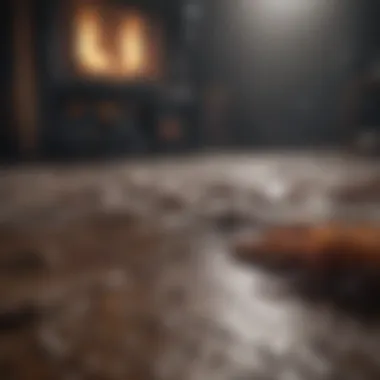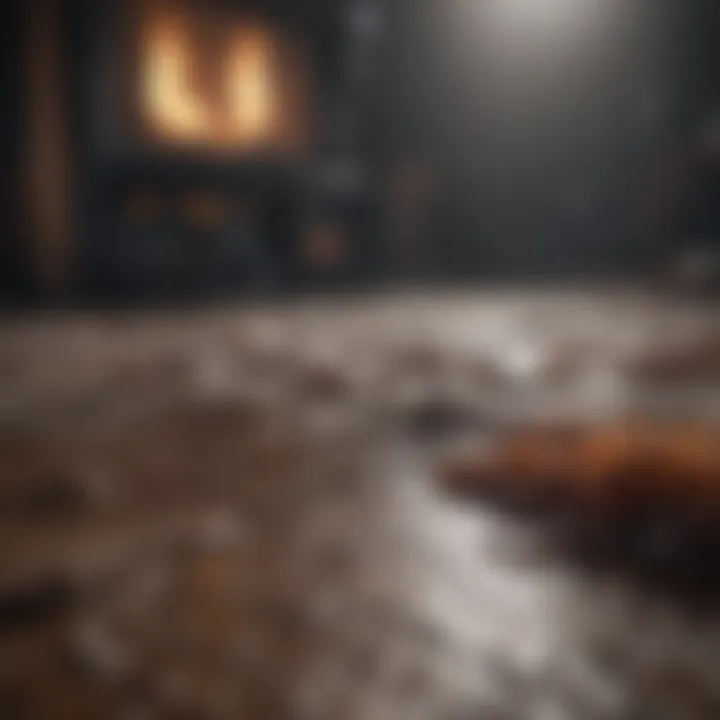Crafting an Immersive Horror Video Game Experience


Intro
Creating an engaging horror video game rests on a delicate balance of atmosphere, storytelling, and interaction. As players seek out thrilling experiences, developers face the challenge of crafting a game that not only frightens, but also captivates. Understanding the core elements that make horror games effective can lead to memorable experiences that linger long after the game is turned off.
In this guide, we uncover the intricate layers of horror game design. From establishing a spine-chilling atmosphere to developing rich narratives, each aspect plays a critical role in engaging the audience. Eyeing not just the horror, we focus on how every feature ties into the unveiling tale, catching players in its intricate web.
Whether you're a budding developer or an avid gamer curious about what breathes life into these thrilling adventures, understanding the mechanics behind great horror games is essential. The journey to master this genre is both daunting and rewarding, and diving into its depths can unveil numerous opportunities for creativity and innovation.
Understanding the Horror Genre
Grasping the nuances of horror is paramount in crafting a riveting video game that captivates players. The horror genre is a rich tapestry woven with threads of fear, tension, and dread. To engage players effectively, developers must delve into its foundation, comprehend its evolution, and manipulate its core elements to create experiences that linger long after the screen goes dark.
Historical Context of Horror Video Games
Examining the historical trajectory of horror in gaming sheds light on its transformative nature. Originating from text-based adventures like Colossal Cave Adventure in the 1970s, horror video games have morphed into visually stunning, narrative-rich experiences. The release of Resident Evil in 1996 marked a significant turning point. Here, developers combined survival elements with atmosphere, creating a claustrophobic dread that set the standard for future titles.
Over the years, the genre has seen numerous innovations. For example, the popularity of indie games like Amnesia: The Dark Descent and Outlast introduced new mechanics that emphasized psychological horror over brute force. This evolution demonstrates that the genre is not static but rather a living, breathing entity shaped by societal fears and technological advancements. Understanding this history is essential for any developer aiming to create an engaging horror title, as it reveals what has resonated with players over time and can guide future creations.
Defining Elements of Horror
The essence of horror lies in its ability to evoke extreme emotions. Some key elements include:
- Atmosphere: A foundational pillar, atmosphere encompasses lighting, sound, and environmental design. A chilling ambiance can stir emotions even before players encounter their first scare.
- Tension and Pacing: Balancing moments of buildup with sudden cues can manipulate player expectations. This pacing keeps players on edge, never quite knowing when the next scare will come.
- Character Development: Characters must resonate with players. When players genuinely care about characters, their fates become intertwined with personal fears, enhancing the tension.
Utilizing these elements effectively can create a rich experience, allowing players to immerse themselves in an unnerving narrative that feels eerily real.
Psychological vs. Supernatural Horror
Differentiating between psychological and supernatural horror is crucial in deciding the tone and style of a game. Psychological horror relies heavily on the human mind's fragility, exploring fears that lurk in the dark corners of consciousness. Titles like Silent Hill masterfully utilize this approach, unsettling players through suspense and character dilemmas rather than overt monsters.
In contrast, supernatural horror taps into the unknown and the supernatural. Games like Fatal Frame leverage paranormal entities to invoke fear. Here, the unsettling presence of ghosts and demons becomes the central threat, pushing narrative boundaries into larger-than-life scenarios. Developers must consider not only what kind of fear they wish to provoke but also how players may react based on their personal experiences with each horror type.
Ultimately, merging these elements creates depth in storylines, enriching the player’s experience. By oscillating between psychological distress and supernatural encounters, one can craft an engaging narrative that continually challenges and surprises the audience.
"The fear of the unknown is the greatest fear." - An essential truth in horror that echoes throughout history.
In summary, understanding the horror genre isn't merely an academic exercise; it is a prerequisite for creating immersive, engaging video games. By delving into its history, defining its core elements, and distinguishing the types of horror, developers equip themselves with the knowledge necessary to draw players into their chilling worlds.
Conceptualizing Your Game
When embarking on the journey of crafting a horror video game, the phase of conceptualizing your game stands as a pivotal pillar. This process sets the tone for every subsequent decision throughout development. It's about finding the heartbeat of your game, where ideas turn into intentions. Failing to invest conscientious thought during this stage can lead to a muddled experience, lacking a cohesive direction.
Taking time to brainstorm and refine your concepts can yield a rich gameplay experience while establishing emotional connections with players. Once you've got a well-structured concept, it becomes easier to weave together narrative elements, design, and mechanics—all crucial for keeping players on the edge of their seats.
Identifying Your Unique Angle
In a genre bustling with creativity, pinpointing your unique angle is paramount. This could be a narrative twist, an innovative gameplay mechanic, or even an unexpected setting. Take a hard look at the multitude of horror games already existing. Is there a fresh take on zombies? What about a psychological thriller that flips the script on control dynamics? Identifying your unique angle not only helps your game stand out but also molds the player's experience in a way that can be both haunting and memorable.
Crafting a Compelling Narrative
Narrative is the backbone of any engaging horror experience, and crafting one isn’t simply about putting together a few spooky events. It requires interweaving elements that resonate with players, tugging at their deepest fears and curiosities.
Building Backstory
The backstory sets the stage for your horror game, giving context to the events that ensue. A well-crafted backstory creates depth, allowing players to immerse themselves more fully. For instance, imagine a secluded village plagued by mystery—each character bears a secret rooted in darkness. This key characteristic of backstory not only enriches world-building but also encourages emotional investment from players, offering them reasons to care about the unfolding horror.
However, crafting backstory isn't solely about exposing the narrative's origins. It’s also about weaving in elements that can be revealed gradually, drawing players into deeper understanding as the story progresses. This layered approach could lead to greater engagement, though writers must tread a fine line; too much exposition can weaken intrigue.
Creating Conflict
Conflict is the driving force of any good narrative. In horror, it often manifests through the protagonist facing insurmountable odds—be it a sinister entity or their own crumbling psyche. The hallmark of engaging conflict is that it feels personal, forcing players to confront dilemmas that resonate on a visceral level. This technique adds a unique flavor to player choices.
Much like a storm brewing before a tumult, the way conflict is introduced shapes how players perceive their environment. The stakes should escalate as players venture forward, adding tension and excitement. The challenges posed can vary widely—from time-sensitive scenarios to moral quandaries. Creators must carefully balance conflict levels, ensuring it elevates the gameplay without feeling overwhelming.


Establishing Resolution
Resolution in a horror game doesn’t always mean closure—in fact, it can often leave players in a state of unease. This ties back to the emotional journey initiated at the start. An effective resolution should feel earned yet ambiguous, lingering in players’ minds long after they've set down the controller.
A poignant resolution characteristic involves a twist that flips expectations, providing a startling epiphany or shocking revelation about characters or events. While this can be a compelling choice, it requires finesse to avoid being perceived as a gimmick. Not every story needs to wrap up neatly; sometimes, the thrill lies in the unknown.
Developing Character Arcs
Character arcs serve as the vehicles through which players experience horror. Well-developed characters can be relatable, making the dangers they face feel all the more real. Whether they evolve through tragedy or triumph, their journeys must resonate. A carefully nuanced arc will engage players, compelling them to invest emotionally as the stakes rise. By focusing on clear motivations and impactful growth, developers can craft memorable protagonists and antagonists alike, enriching the player's experience and amplifying the horror.
Game Mechanics and Design
In the world of horror video games, the nuances of game mechanics and design play a vital role in shaping successful player experiences. Mechanics dictate the interactions between players and the game’s environment, ensuring that fear is not only suggested but deeply felt. It’s not simply about what players do; it’s about how they feel while doing it. A well-crafted gameplay experience can draw players in, keeping them on the edge of their seat while also allowing them to immerse themselves in the chilling narrative.
By entwining player agency with gripping storytelling, developers can craft instances of anxiety and suspense that resonate long after the game ends. Therefore, understanding the intricacies of core gameplay mechanics, level design principles, and the integration of fear-based elements becomes paramount in realizing a truly haunting experience.
Core Gameplay Mechanics
Exploration
Exploration serves as the lifeblood of most horror video games. It’s where players dive headfirst into atmospheric worlds brimming with hidden secrets and lurking threats. The act of exploring in a game not only builds tension but also fosters a sense of discovery. Engaging players through exploration allows them to unveil layers of psychological horror that might otherwise remain hidden.
One of the biggest traits of exploration is its ability to shift the player's perception of safety. As they wander through dimly-lit corridors or desolate landscapes, the unknown amplifies their unease. This unique feature—allowing players to dictate the pace of their dread—provides a significant advantage. However, overly linear exploration can dilute that tension, which is a consideration developers must balance carefully.
Puzzle Solving
Puzzle solving plays a crucial role in engaging players’ minds while simultaneously instilling fear. It serves as an intellectual challenge that interweaves with the game’s narrative, encouraging players to think critically as they navigate through increasingly perilous situations. The beauty of puzzle solving is its capacity to extend gameplay, bridging moments of calm with bursts of intense action or terror.
A key characteristic of effective puzzles in horror settings is how they often hinge on narrative elements, like discovering a character's backstory or unearthing the motivations behind malevolent forces. This means they contribute positively to immersion. However, there’s always a risk; if puzzles are too complicated, frustration may overshadow the intended fear, driving players away instead of captivating them.
Combat Mechanisms
Combat mechanics can either provide a means of escape or generate further tension, depending on execution. In horror games, conflict often arises with overwhelming odds, which can elevate fear. The challenge lies in striking a balance between empowering players through combat skills while ensuring they feel vulnerable against their opponents.
One defining characteristic of combat in horror gaming is resource scarcity. Limiting ammunition or health can enhance anxiety, forcing players to weigh their options carefully. This pushes players to recognize the threat around them, creating an astonishingly immersive experience. Yet, overly punishing combat can lead to a sense of helplessness, which may alienate some players.
Level Design Principles
Level design principles serve as the skeleton of horror video games, shaping not only how players traverse the landscape but how they experience fear in those spaces. Effective level design creates a rhythm of tension and respite, guiding players intentionally yet deceptively.
A critical consideration is layering spaces with intersecting paths, ensuring that players always feel a blend of familiarity and disorientation. Players should feel that they have agency, yet their movement should be shrouded in uncertainty, lending itself to that tangible, creeping dread. The layout of each level should serve storytelling; every room, corridor, and environment detail contributes to a narrative that builds horror in subtle, yet powerful ways.
Integrating Fear Mechanics
Jump Scares
Jump scares remain a cornerstone in horror gaming, used effectively to provoke immediate reactions and sharp fright. They exploit natural instincts, catching players off guard through brilliant timing and anticipation. When used judiciously, jump scares can elevate tension, providing a momentary spike in adrenaline that keeps players engaged.
Despite being a popular choice, over-reliance can lead to desensitization. Players may begin to anticipate these moments, which dilutes their effectiveness. Therefore, it’s crucial to craft jump scares in a manner that feels organic within the storyline, rather than shoehorned in for shock value alone.
Sound Cues
Sound cues can be atmospheric whispers that send shivers down the player's spine. Unlike visual elements, auditory signals add layers of subtler horror. The eerie creak of a door, the distant echo of footsteps, or hushed voices can heighten tension without revealing much. These sounds create suspense, forcing players to confront anxieties rooted in their imagination.
The key characteristic of effective sound cues is their ability to distract and mislead, guiding players' emotions as they traverse haunting landscapes. Players should feel the weight of each sound, knowing that something’s lurking around the corner, even if it remains unseen. However, if sound cues are overused or not calibrated properly, they risk becoming background noise rather than enhancing the horror experience.
Environmental Design
Environmental design mirrors the narrative, encapsulating players into the world they inhabit. It’s not just about aesthetics; it’s about evoking feelings of dread through context and space. Whether it’s the claustrophobic confines of a haunted house or the vast emptiness of a ghost town, each environment must play its part in facilitating fear.
A unique feature of environmental design is how levels can shift upon players’ actions. For instance, actions taken in one area may lead to dramatic changes in another, mirroring the cause and effect narrative often found in ghost stories. This adds depth to the gameplay but can also present challenges. Designers must ensure environments are not confusing, preventing players from feeling lost amidst the horror.
In summary, game mechanics and design are paramount to creating a horror experience that resonates with players. By weaving exploration, puzzle-solving, combat, and thoughtful level and environmental design, developers can craft chilling experiences that linger far beyond the final screen.


Art and Aesthetic Choices
Art and aesthetics form the backbone of a horror video game, acting as the visceral glue that binds every element together. The way a game looks, sounds, and feels can often be the deciding factor in whether it captivates its audience or fades into obscurity. For those venturing into the dark alleys of horror game development, taking a meticulous approach to art and aesthetics is non-negotiable. Each detail—from the color palette to character design—creates an emotional backdrop that can amplify tension, fear, and an overall haunting experience.
Visual Style and Theme
The visual style of a horror game can range from hyper-realistic graphics to stylized art. Choosing the right stylistic direction is imperative. A gothic theme might employ rich dark colors with intricate details that evoke a feeling of decay, while a survival horror game may opt for grimy, muted tones, thereby reflecting a world gone awry. The visuals not only set the stage but also inform gameplay. For example, in games like Silent Hill, thick fog creates a sense of claustrophobia and uncertainty, forcing players to rely on their instincts and in-game sounds.
- Using a specific color palette can enhance emotional responses. For instance:
- Red often symbolizes danger and alarm.
- Blue hues can instill feelings of coldness and isolation.
Implementing a cohesive theme across all visuals ensures players remain immersed in the narrative. The consistency in design influences how players perceive the story and can make even mundane tasks, like solving a puzzle, feel thrilling or suspenseful.
Character and Monster Design
The characters and monsters breathe life into your game. Unique designs help in forging connections between players and the game’s universe. The auditory and visual elements of characters profoundly affect gameplay and emotional engagement. Think about Resident Evil and its iconic characters. Each has its own story, mannerisms, and visual aesthetic that enhances the entire game's atmosphere.
When designing your antagonists, consider these aspects:
- Silhouette: A distinct silhouette can make a character instantly recognizable, even in shadow.
- Facial Expression: Expressions convey emotions that resonate with the player, establishing empathy or fear.
- Backstory: A well-developed backstory lends depth—players feel compelled to either defeat or understand them.
Creating visually unappealing monsters isn't just about aesthetics; it's about evoking emotional responses. Monsters that embody primal fears—like darkness or decay—are inherently more terrifying. Let’s face it, few things haunt dreams like a distorted version of something familiar.
Atmospheric Sound Design
Sound design often gets overshadowed by the visuals but plays a crucial role in crafting the game's atmosphere. The right audio can suffocate players in fear or propel them into the bravado of a protagonist. Sound effects serve as cues, signals, and unsettling echoes that create anxiety or surprise. A slow, ambient sound might create an illusion of security, making players let their guard down, only for a sudden loud crash to jolt them back into alertness.
An effective soundscape might incorporate:
- Creepy Sound Effects: Rustling leaves, distant whispers, or the creaking of an old floorboard can heighten suspense.
- Dynamic Music: Use a score that adapts to the gameplay. Music ramps up during intense scenes and fades into silence during quieter moments, creating a rollercoaster of emotions.
One would be remiss not to refer to a hallmark of horror games, the jump scare. These are often accompanied by sudden, loud noises that break the silence—a classic tactic for eliciting shock. However, do remember that overusing this method can dull its effectiveness; it must be strategically placed within the game.
"The unsettling nature of horror thrives in an atmosphere that engages all senses. Adequate sound design can amplify every visual effect, making the players' hearts race and their palms sweat."
Testing and Feedback
Testing and feedback play a crucial role in shaping the final product of a horror video game. Developing an engaging gameplay experience, especially in a genre that relies heavily on atmosphere and emotional response, requires constant iteration based on player experiences. Ensuring that players feel the right kind of fear, tension, and delight is paramount. This section dives into the processes that not only test gameplay but also gather insights on player reactions to refine the game further.
Playtesting Techniques
When creating a horror game, understanding your audience's experience is vital. Playtesting is one of the most significant ways to get a feel for how your mechanics and storytelling are landing. In this stage, different approaches can be utilized, such as closed alpha tests with select players or open beta phases that invite broader participation. Observing players as they navigate through your game can unearth a range of invaluable information. Developers might notice where players jump, where they feel bored, or which areas cause confusion. It’s all about capturing those raw reactions.
A few effective playtesting techniques include:
- Silent Observation: Watching players as they interact without any interference allows you to see organic reactions to jump scares or plot twists.
- Think-Aloud Protocol: Asking players to voice their thoughts while playing provides insights into their decision-making process and emotional responses.
- Post-Play Discussions: Engaging players in conversations shortly after their experience can help clarify their perceptions and feelings toward specific moments in the game.
These techniques can reveal modifications needed to ramp up the game’s horror elements, making them potentially scarier or adding layers to the puzzles.
Gathering Player Feedback
One of the cornerstones of refining your horror game lies in gathering meaningful feedback from your players. Two significant methods for collecting this information are surveys and focus groups, each bringing its own set of strengths to the table.
Surveys
Surveys serve as an efficient way to gather structured feedback from a wide audience. By formulating specific questions related to gameplay mechanics, story elements, and general player enjoyment, developers can gather quantifiable data. A key characteristic of surveys is the ability to reach a larger group, providing insights that correlate with broader player trends.
- Benefits: They are accessible and relatively easy to distribute, offering insights that can be quickly analyzed.
- Unique Features: Online platforms like Google Forms or SurveyMonkey allow customization of questions, displaying them visually for easy understanding.
- Advantages/Disadvantages: The main disadvantage is that surveys cannot capture qualitative nuances unless they include open-ended questions; otherwise, they rely mainly on statistical feedback.
Focus Groups
Focus groups provide a deeper dive into player experiences by assembling small groups of players to discuss their thoughts and feelings about the game comprehensively. This method can gather rich qualitative feedback that surveys may lack. The key characteristic of focus groups is the dynamic interaction among participants, often leading to insights that individual thoughts alone might not cascade.


- Benefits: They create a space where players can voice opinions freely, which can elicit deeper, more thoughtful responses.
- Unique Features: The facilitator can probe interesting points during discussions, clarifying and digging deeper into player experiences.
- Advantages/Disadvantages: One downside might be groupthink, where dominant voices overshadow quieter participants, potentially skewing the overall feedback.
Collectively, these gathering methods allow for a more triangulated approach to feedback, enhancing the prospect of creating a game that resonates deeply with players.
Iterative Design Process
The iterative design process involves revising and improving game mechanics based on the testing and feedback received. This cycle of creating, testing, receiving feedback, and adjusting is vital for honing all elements to fit your vision. It allows developers to take player insights seriously and implement changes that elevate their horror experience, leading to a compelling journey that scares and captivates the audience.
Market and Audience Considerations
Understanding the market and audience is essential when developing a horror video game. Creating a game that resonates with players not only enhances the immersive experience but also boosts the game's visibility and success in a saturated market. Articulating a clear understanding of your target audience allows developers to shape compelling narratives, design captivating gameplay and create marketing strategies that appeal.
Identifying Target Demographics
To effectively engage players, identifying target demographics becomes pivotal. Who are the individuals that are drawn to horror video games? Typically, this group includes a variety of ages, but there seems to be a notable prevalence in younger adults, particularly those in their late teens to mid-thirties. Factors like gender can also influence the preference, with studies indicating that while male players dominate the genre, female gamers are a growing demographic, showing strong interest in horror experiences.
Understanding the motivations behind gameplay choices is also key. For instance, some players seek an adrenaline rush, while others are more inclined towards narrative depth or character development. Conducting surveys and analyzing gaming forums like reddit.com helps gather this information. The more precise the profile, the better aligned the game's elements can be with players' expectations.
Analyzing Trends in Horror Gaming
Staying updated with trends in horror gaming can provide useful insights for game developers. The genre has evolved significantly, from 8-bit platformers to today's intricate virtual reality experiences. Recently, narratives incorporating psychological horror like Silent Hill have gained traction alongside supernatural themes seen in titles such as Resident Evil.
Moreover, the rise of indie games has reshaped the landscape, bringing innovative ideas from smaller studios that often capture player interest with unique storytelling and gameplay mechanics. Trends are continuously evolving; developers should keep their ears to the ground, attending gaming conventions or following industry news on platforms like britannica.com and gaming blogs.
Marketing Strategies for Horror Games
Marketing in the horror genre demands creativity that reflects the eerie atmosphere of the games themselves. Integrating the game’s thematic elements into marketing campaigns can trigger curiosity and excitement among players.
Social Media Campaigns
Social media campaigns are a recent go-to strategy for many horror game developers. The interactive nature of social platforms allows developers to engage with their audiences directly and build communities around the game. A crucial aspect of these campaigns is the use of suspenseful teasers or trailers that encapsulate the essence of fear and thrill, enticing potential players.
The unique feature here is that social media allows for the rapid spread of viral content, which is particularly beneficial in the horror genre where anticipation and word-of-mouth can drive game interest. However, ensuring that the content remains fresh while maintaining a consistent aesthetic can be challenging.
Influencer Collaborations
Collaborating with influencers also proves to be an efficient marketing strategy. Influencers who focus on gaming often have dedicated followers; their endorsement can create a significant buzz around the game. This approach works as the influencer's audience often aligns with the target demographic of horror games, leading to increased visibility.
A distinct characteristic of influencer collaborations is that they can create organic content that resonates more with audiences than traditional advertisements. However, developers must choose partners wisely, as an influencer's reputation can impact the game's perception in the market.
Choosing the right strategy to identify your audience and adapt to their preferences is central in creating a horror game that captivates while ensuring successful market penetration.
Future of Horror Gaming
Discussing the future of horror gaming is not just a fleeting thought; it’s a vital conversation for developers looking to stay ahead of the curve. The horror genre thrives on transformation, and as technology advances, so too does the landscape of interactive fear. By focusing on this evolution, creators can discover ways to not only engage current audiences but also attract a new generation of players. Strategies that take into account emerging technologies, collaborations across different media, and shifting player expectations can elevate the gaming experience beyond traditional scares, ensuring that the thrill of horror remains relevant in an ever-changing market.
Emerging Technologies and Trends
The role of emerging technologies in horror gaming cannot be overstated. With advancements in virtual reality, augmented reality, and artificial intelligence, the ways in which players experience fear have reached new heights.
- Virtual Reality (VR): This technology places players right in the middle of a horror experience. Titles like "Resident Evil 7: Biohazard" demonstrate how VR can amplify tension, drawing players into the unsettling environments where they are not just observers, but part of the narrative. As more accessible VR devices enter the market, developers have an opportunity to craft experiences that are visceral and immersive.
- Augmented Reality (AR): Games like "Pokémon GO" showed how AR can alter everyday spaces, inviting a creative approach to horror. Imagine an AR horror game where shadows from real-life locations project a sense of dread or summon a ghostly figure. This merging of reality and the supernatural can be a game-changer.
- Artificial Intelligence (AI): Enhanced AI can offer unpredictable enemy behaviors, making every encounter uniquely terrifying. When a character anticipates a player's actions, it creates a sense of constant threat. Developers can craft stories where NPCs seem to learn from players, heightening the horror tension significantly.
These technologies invite players into a new realm of storytelling, promoting a more profound connection with the experience.
Collaboration with Other Media
Another exciting facet of horror's future lies in its ability to collaborate with other forms of media. The interplay between horror video games and films, books, or even live theater can elevate narratives and deepen engagement. Take for instance, how the "Silent Hill" series has inspired films, and vice versa. This exchange of concepts and themes allows audiences to explore varied interpretations of horror.
- Transmedia Storytelling: By delivering content across platforms, developers can expand the world and backstory in ways that a standalone game cannot. A horror game might tie in with a graphic novel or an animated series that intertwine their plots. Players get more layers to peel back, which can create an enriching experience.
- Live Experiences: Imagine an escape room that utilizes elements from a horror video game. Players could step directly into the game world and engage in real-time decisions affecting the outcome. This casual merging of gaming and real-life entertainment can attract diverse audiences who crave interactive narratives.
These collaborations deepen audience immersion, ensuring that horror maintains a foothold in modern entertainment.
Evolving Player Expectations
As the gaming landscape changes, so too do player expectations. Today’s players are looking for more than just jump scares; they seek emotional investments and intricate narratives. Games now need to explore deeper psychological themes to resonate with their audience.
- Character Depth: A well-crafted character arc can be the difference between a forgettable game and a memorable one. Players today want to invest emotionally in characters to feel their pain, fear, and resolve. Games like "The Last of Us" showcase how character-driven stories are critical in creating emotional attachments that extend beyond just gameplay.
- Interactive Storytelling: The rise of choices and consequences means players expect their decisions to significantly impact the game’s storyline. This level of interaction demands a more intricate design, where branching narratives are not just a gimmick but essential parts of the gaming fabric.
- Social Interactions: Multiplayer experiences have evolved; players now desire a space to connect with others, making community elements crucial. A horror game that fosters collaboration or competition can create memorable encounters and shared experiences, driving replayability.
"Understanding what players desire is just as important as what they fear. The emotional stakes in horror games can be just as terrifying as the monsters themselves."
Navigating these player expectations will be essential in crafting the next generation of horror games that not only terrify but also resonate with stories and experiences players cannot forget.



